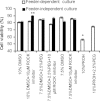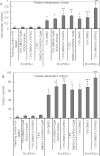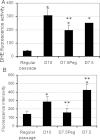Enhancement of cell recovery for dissociated human embryonic stem cells after cryopreservation
- PMID: 20014103
- PMCID: PMC3593169
- DOI: 10.1002/btpr.358
Enhancement of cell recovery for dissociated human embryonic stem cells after cryopreservation
Abstract
Due to widespread applications of human embryonic stem (hES) cells, it is essential to establish effective protocols for cryopreservation and subsequent culture of hES cells to improve cell recovery. We have developed a new protocol for cryopreservation of dissociated hES cells and subsequent culture. We examined the effects of new formula of freezing solution containing 7.5% dimethylsulfoxide (DMSO) (v/v %) and 2.5% polyethylene glycol (PEG) (w/v %) on cell survival and recovery of hES cells after cryopreservation, and further investigated the role of the combination of Rho-associated kinase (ROCK) inhibitor and p53 inhibitor on cell recovery during the subsequent culture. Compared with the conventional slow-freezing method which uses 10% DMSO as a freezing solution and then cultured in the presence of ROCK inhibitor at the first day of culture, we found out that hES cell recovery was significantly enhanced by around 30 % (P < 0.05) by the new freezing solution. Moreover, at the first day of post-thaw culture, the presence of 10 microM ROCK inhibitor (Y-27632) and 1 microM pifithrin-mu together further significantly improved cell recovery by around 20% (P < 0.05) either for feeder-dependent or feeder-independent culture. hES cells remained their undifferentiated status after using this novel protocol for cryopreservation and subsequent culture. Furthermore, this protocol is a scalable cryopreservation method for handling large quantities of hES cells.
Copyright 2009 American Institute of Chemical Engineers
Figures






Similar articles
-
The roles of apoptotic pathways in the low recovery rate after cryopreservation of dissociated human embryonic stem cells.Biotechnol Prog. 2010 May-Jun;26(3):827-37. doi: 10.1002/btpr.368. Biotechnol Prog. 2010. PMID: 20077485 Free PMC article.
-
ROCK inhibitor improves survival of cryopreserved serum/feeder-free single human embryonic stem cells.Hum Reprod. 2009 Mar;24(3):580-9. doi: 10.1093/humrep/den404. Epub 2008 Dec 4. Hum Reprod. 2009. PMID: 19056770
-
The ROCK inhibitor Y-27632 enhances the survival rate of human embryonic stem cells following cryopreservation.Stem Cells Dev. 2008 Dec;17(6):1079-85. doi: 10.1089/scd.2007.0247. Stem Cells Dev. 2008. PMID: 19006455
-
Application of Rho-associated protein kinase (ROCK) inhibitor to human pluripotent stem cells.J Biosci Bioeng. 2012 Dec;114(6):577-81. doi: 10.1016/j.jbiosc.2012.07.013. Epub 2012 Aug 13. J Biosci Bioeng. 2012. PMID: 22898436 Review.
-
[Human pluripotent stem cell and neural differentiation].Brain Nerve. 2008 Oct;60(10):1165-72. Brain Nerve. 2008. PMID: 18975604 Review. Japanese.
Cited by
-
Bioprocessing of cryopreservation for large-scale banking of human pluripotent stem cells.Biores Open Access. 2012 Oct;1(5):205-14. doi: 10.1089/biores.2012.0224. Biores Open Access. 2012. PMID: 23515461 Free PMC article.
-
Functional human iPSC-derived alveolar-like cells cultured in a miniaturized 96‑Transwell air-liquid interface model.Sci Rep. 2021 Aug 23;11(1):17028. doi: 10.1038/s41598-021-96565-4. Sci Rep. 2021. PMID: 34426605 Free PMC article.
-
Matrix-free human pluripotent stem cell manufacturing by seed train approach and intermediate cryopreservation.Stem Cell Res Ther. 2024 Mar 25;15(1):89. doi: 10.1186/s13287-024-03699-z. Stem Cell Res Ther. 2024. PMID: 38528578 Free PMC article.
-
The roles of apoptotic pathways in the low recovery rate after cryopreservation of dissociated human embryonic stem cells.Biotechnol Prog. 2010 May-Jun;26(3):827-37. doi: 10.1002/btpr.368. Biotechnol Prog. 2010. PMID: 20077485 Free PMC article.
-
Protein kinase A inhibitor, H89, significantly enhances survival rate of dissociated human embryonic stem cells following cryopreservation.Cell Prolif. 2016 Oct;49(5):589-98. doi: 10.1111/cpr.12278. Epub 2016 Aug 3. Cell Prolif. 2016. PMID: 27484641 Free PMC article.
References
-
- Améen C, Strehl R, Björquist P, Lindahl A, Hyllner J, Sartipy P. Human embryonic stem cells: current technologies and emerging industrial applications. Crit Rev Oncol Hematol. 2008;65:54–80. - PubMed
-
- Cohen S, Leshanski L, Itskovitz-Eldor J. Tissue engineering using human embryonic stem cells. Methods Enzymol. 2006;420:303–315. - PubMed
-
- Rendal-Vázquez ME, Maneiro-Pampín E, Rodríguez-Cabarcos M, Fernández-Mallo O, López De Ullibarri I, Andión-Núñez C, Blanco FJ. Effect of cryopreservation on human articular chondrocyte viability, proliferation, and collagen expression. Cryobiology. 2001;42:2–10. - PubMed
-
- Heng BC. Effect of Rho-associated kinase (ROCK) inhibitor Y-27632 on the post-thaw viability of cryopreserved human bone marrow-derived mesenchymal stem cells. Tissue Cell. 2009;41:376–380. - PubMed
Publication types
MeSH terms
Substances
Grants and funding
LinkOut - more resources
Full Text Sources
Other Literature Sources
Research Materials
Miscellaneous

